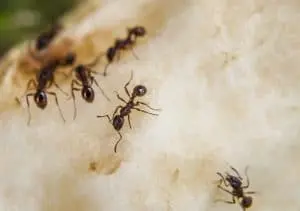No one likes finding an endless parade of ants marching along a windowsill, wall, or countertop, but almost everyone has had these persistent pests invade their home at some point. One of the most common—and annoying—pests found in our homes, ants come indoors in search of food, water, and shelter. They are attracted to foods like sugar, protein, and grease, as well as rotten or moldy wood. Doors, windows, and cracks in walls or foundations give these colonizing creatures easy access, and once inside, they are hard to get rid of for good. Discover the best methods for ant control in Ohio now.
Identifying Ant Species
To successfully tackle an ant infestation, you first need to identify the species. There are a variety of common species that invade homes. They can range from 1/32 to 3/4 of an inch in size and can be yellowish, light brown, reddish brown, or black in color. Luckily, most species of ants found in Ohio don’t bite or sting. The most common types found in this region include:
- Pavement ants
- Carpenter ants
- Pharaoh ants
- Odorous house ants
Ants are social creatures that form colonies ranging anywhere in size from hundreds to several thousands of insects. Certain members of the colony perform different jobs. For example, each colony has one or more queens to lay eggs. There are worker ants who search out food and water. In their travels, the workers create invisible scented trails in order to find their way back to the nest. Other members are called swarmers. These ants have wings and are often confused with termites. Here are some easy ways to distinguish between termites and swarmer ants.
- Ants are narrow at the waist, while termites have consistently wide bodies.
- Ants have bent antennae, while termites have straight antennae.
- Both ants and termites have four wings, but ants have longer front wings, while a termite’s wings are all the same size.
- Ant wings are clearish or brownish in color, while termite wings are whitish or gray and shed easily.
Ant Control in Ohio Homes
When you see one or two ants in your home, chances are it’s not alone. These social insects usually build their nests outside but enter your home for food and water. However, some ants will set up shop in walls, cracks, and crevices, so the first step in controlling an ant infestation is to locate the nest. Once you find it, you can target the entire colony instead of just killing a couple of ants.
If you see a line of moving ants, you can usually follow them to find the nest, but if that does not work, try putting a dab of honey or jelly near the procession and watch where they take the food.
Preventing an ant invasion is easier than destroying a colony once it is established. The best way to avoid an invasion is to eliminate their food sources. Clean up crumbs and put away leftovers, and make sure that food left out on the counter or in the cabinets is in sealed containers. Fix leaky pipes to avoid rotting wood and providing ants with a water source, and caulk up cracks and crevices that give pests easy access to your home.
Treatment
When treating for ants, use insect control products sparingly. Only apply the products to the nest or small areas that are infested. If you treat an entire room or area, they will find a way to avoid it. When you treat near the nest or in a crack where you’ve seen pests, the worker bees do the rest by bringing the product back to the colony.
There are many insect control products on the market claiming to control ants, but only a few may help in your situation. It’s difficult to pick the right one and to completely eradicate a colony, so it may be best to leave the task to professionals.
Is it better with baits? Ant baits work the same way as other insect control products—worker ants feed on the product, then take it back to the nest. Baits keep the product contained, and when used carefully, may be a safer alternative to spraying. Place the baits near where you’ve seen ant activity or along their trails.
Call the Professionals
To get rid of ants or other pests, contact Free Spray Lawn Care at 419-529-5296. We can help you determine the proper method of treatment and eradicate the infestation once and for all.



Comments (0)
Thanks for your comment!
Thanks for your feedback! Your comments have been successfully submitted! Please note, all comments require admin approval prior to display.
Error submitting comment!
There is a problem with your comment, please see below and try again.